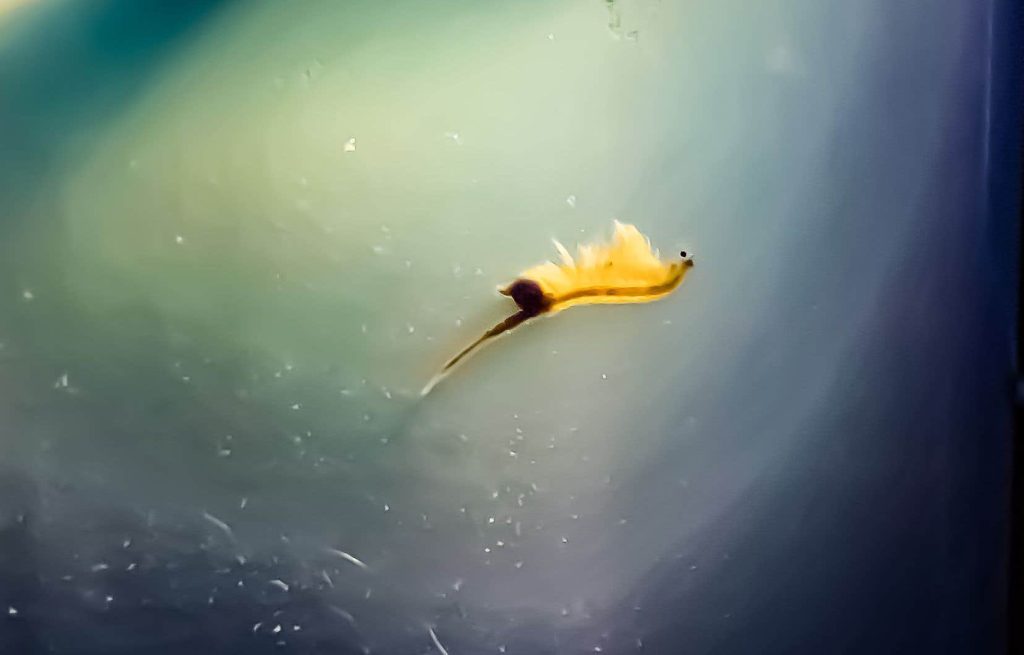The oceans play an important role in slowing global warming. So far, they’ve diverted a third of their CO2 emissions into their abyss2 humanity. However, the mechanisms regulating this massive carbon void still hold many secrets for scientists.
On Cape Cod Beach, not far from the Woods Hole Oceanographic Institution (WHOI), a flock of cormorants and seagulls skillfully dive into the water and come out with fish in their beaks. Tidal deposits of horseshoe crabs, a straight-forward brown arthropod from prehistoric times, ashore.
The upper layers of the ocean are full of life. The sun allows the growth of microscopic algae that absorb carbon dioxide2 dissolved in water. These algae are at the base of the food chain. When the animals that eat them die or defecate, the remains – very rich in carbon – sink to the sea floor.
These particles are nicknamed “sea ice,” assures Ken Busseler, a chemist who welcomes duty In his lab whoi. While giving his explanations, Mr. Busseler wiggles his fingers to imitate falling soft snow. Marine snowfall is the most important transporter of carbon from the surface to the deep ocean.
Note, however, that not all sea ice reaches the sea floor. The majority of chips are the delight of the inhabitants of the “Twilight Layer” (” Twilight Zone in English), which extends from about 100 to 1000 metres. They are intercepted and eaten by fish, zooplankton, crustaceans and squid.
The largest migration on the planet
The animals of the twilight layer affect the flows of carbon in a second way: every night, they visit the surface of the ocean to eat algae there, protected from predators thanks to the darkness. This is, according to biologists, the largest migration on the planet in terms of biomass. And this rapid ascent, on the back of the shrimp, constitutes a second very important carbon carrier toward the cliff.
Through these two mechanisms, billions of tons of carbon are transported each year to the sea floor, where it remains isolated from the atmosphere for centuries. These phenomena were already naturally occurring before humans emit greenhouse gases, but they are now on high alert.
However, it is difficult to know whether the carbon cycle in the seas will change with climate change or overfishing. “I’ve been working on these questions for 35 years, but it’s very hard to tell because of the many pathways carbon can take in the ocean,” Buesseler says.
Carbon fluxes vary greatly depending on geography, temperature, season, etc. In order to explain these differences, Mr. Buesseler multiplexing measurements of marine snow flow in different environments. To achieve this, she has been relying on underwater cameras for several years.
“Using the camera, we have information about what’s happening inside the ocean 24 hours a day, seven days a week,” said Elena Ceballos Romero, a postdoctoral researcher at the World Health Organization, who was interviewed via video since Europe, where she shared at scientific conferences.
last August, mr.I Rode Ceballos Romero RV Endeavor, a research ship that has sailed in the northwest Atlantic Ocean to carry out several scientific missions on the aurora layer. She was responsible for the Twilight Zone Explorer, a self-driving underwater vehicle that can descend to a depth of 6000 meters, equipped with a high-resolution camera.
The principle is simple: the camera is facing upwards. When the particles fall, they land on his lens. Thanks to an image collected over hours, days, or even months, experts can count marine snowflakes, measure their size, and guess their nature. The carbon content can then be estimated.
“sediment traps”
“Our team went to the ship last year [en juillet 2021], but we only saw very weak carbon movements. This year, on the other hand, we have observed very strong flows, but we do not yet know the reason, ”says the young researcher. The timing of the cruise, in August instead of July, may be in question, but this is only a guess.
More traditional methods also make it possible to measure sea ice flow. “Sediment traps” consist, for example, of cups placed at certain depths, which collect everything that is located there. However, these methods require a lot of manipulation by researchers. With cameras, the ultimate goal is to deploy dozens of autonomous robots that can record data for months.
Knowledge of carbon fluxes in the oceans is not only used to advance basic science. It is also part of a group of applied sciences aimed at determining whether it is possible to artificially stimulate ocean carbon sequestration. The idea is to “enrich” the seas with iron, an essential nutrient whose scarcity often limits the growth of microscopic algae near the surface.
Geoengineering is clearly controversial: Will humanity harm the planet further by trying to heal it? Buesseler, who has been interested in iron enrichment for years, believes the impact of this approach on marine ecosystems needs to be evaluated, but he believes the climate crisis is too serious to stand idly by.
So he created a group, Exploring Ocean Iron Solutions, which brings together dozens of scientists and aims to assess, with complete objectivity and within a well-established ethical framework, whether iron enrichment is worth the effort. He explains that the idea is to do research before someone markets a stupid project for the wrong reasons. »
In the past, initiatives have evaluated the extent to which iron supplementation promotes plant growth (and thus carbon dioxide uptake2) on the roof. The next step is to understand, in different marine environments, the proportion of this carbon that crosses the auroral layer toward the sea floor. “We have to be absolutely sure that we don’t overestimate the benefits of this approach,” Buzeler concludes.
Let’s see in the video

“Hardcore beer fanatic. Falls down a lot. Professional coffee fan. Music ninja.”







More Stories
Why doesn't water come out of the bottle in free fall? Experience
Skyrmions, increasingly promising magnetic particles for future computers
A very simple tip for better brainstorming